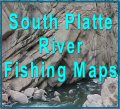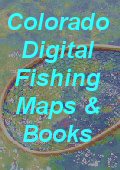Fly-Fishing Trappers Lake --
A Flat Tops Treat
by Ron Belak
Photos and captions by Al Marlowe
Trappers Lake, the crown jewel of Colorado's high lake fisheries, offers spectacular angling experiences that most fly-fishers bypass. Special fishing regulations, easy access, and prolific hatches create some of the state's best stillwater fly fishing for larger wild cutthroat trout. The lake's relative isolation and a lesser interest in lake fishing result in thinner crowds than on most major Western rivers.
Nestled among dense pine, spruce, and fir, Trappers Lake lies at an elevation of 9,627 feet in the Flat Tops Wilderness of northwestern Colorado. Immense rock walls composed of repetitive lava flows tower 1,500 feet high and form a spectacularly scenic backdrop. These cliffs were carved over 10,000 years ago by an alpine glacier whose meltwater filled the lake to about its present 180-foot depth. With a surface area of 320 acres, Trappers is one of Colorado's largest natural lakes.
Trappers Lake is home to a self-sustaining population of Colorado River cutthroats. Since 1914, the Colorado Division of Wildlife has stripped eggs and sperm from the spring spawners and raised the resulting fry in its hatcheries. Fingerling trout are then planted into more than 140 of Colorado's high country lakes.
Because of special fishing regulations, this population has thrived in recent years. Cutthroat are abundant and average 12 to 15 inches but occasionally exceed 18 inches. Angling is restricted to artificial flies and lures, and any cutthroat over 10 inches must be returned to the water immediately. Up to eight cutts 10 inches or less can be kept. Fishing is prohibited in all inlets and upstream for one half mile, in the outlet and downstream to the falls, and within 100 feet of inlet and outlet streams. There is no bag limit on brook trout as their propensity to overpopulate threatens the cutthroat population.
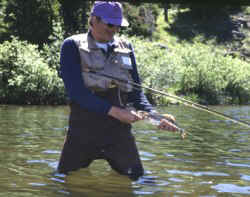
Wild cutthroat from Trappers Lake taken by Ron Belak. East shoreline fishing is best in the morning. Photo by Al Marlowe
Before dashing-off to this excellent fishery, one needs to secure the proper equipment to assure a successful outing. Because of the ever-present possibility of strong wind, I prefer to fish Trappers with a 5 or 6 weight rod. I fish dries and nymphs with a floating line, but I also carry a full-sinking line for trolling or fishing streamers.
Because of dense willows lining the shore, you need to enter the water to backcast, and this can be accomplished either by wading or floating. For wading, I recommend chest-high neoprene or breathable waders. Wet-wading is not advised because water temperatures seldom exceed 60 degrees. Wading allows you to scout the most shoreline in the least amount of time, and you can spot more fish because of your greater height above the water. However, wading restricts you to fishing the shore, and some trout always rise beyond casting range. Your float tube or a rented rowboat or canoe can provide access to deeper water farther offshore. Motors are not allowed on Trappers Lake.
Trappers usually thaws around the first of June, but can open two weeks earlier or later depending on weather. Fishing is good during the two weeks following thawing, as hungry cutthroat cruise the shallows. Black Marabou Leeches and Wooly Buggers or orange soft hackles are effective when fished on full-sinking lines, and midges offer some early dry fly fishing. After this two-week ice-out period, angling slows down as the cutthroat migrate into the streams to spawn. However, the angling really heats-up again when surface water temperatures climb above 52 degrees, terminating the spawn and initiating many of the hatches for which Trappers is famous.
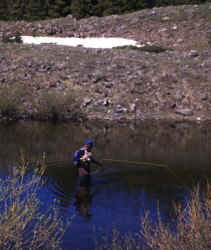
The outlet of Trappers Lake is a good place to fish to rising cutthroats. Photo by Al Marlowe
The key to successfully fly-fishing Trappers Lake is a two-part process. First, one must locate trout. Second, one needs to properly present a fly that will entice a strike.
The best place to locate trout in Trappers Lake is north of a line drawn from Scott's Bay to Cabin Creek. Cutthroat concentrate here because this is the home of their prime food supply -- bottom-dwelling invertebrates. These invertebrates, consisting primarily of scuds, mayflies, midges, and caddis, are largely confined to the littoral zone -- that portion of the lake extending from shore to the deepest depth of rooted plants. In Trapper's Lake, this depth is about 20 feet. This relatively small northern portion of the lake has a gently dipping, easily wadable shelf and a well-worn trail that hugs the shoreline. However, good fishing can be found in shallow areas anywhere around the lake. Deadfall and steep terrain make the south end difficult to access, but it offers both good fishing and solitude.
Although Trappers is thermally stratified from the end of June into October, temperature is not a major factor controlling cutthroat distribution. Only when near-shore water temperatures exceed 65 degrees do fewer trout cruise the shallows. Similarly, oxygen is abundant in all but the lake's deepest waters and does not appear to influence cutthroat distribution during the open water season.
Trout cruise the shallows in schools, and in the absence of directly seeing them, look for rise forms. However, trout attempt to conceal themselves with any available cover, such as overhanging willows, shadows, the shelf edge, or weed beds. Trout are less wary and occur in greater numbers in the shallows during morning and evening when the sun is off the water. This is when the fishing is generally best, and these times coincide with the better insect hatches and least amount of wind. Mid-day is a slow time for fishing unless there is considerable cloud cover.
Wind produces a rippled surface, making trout difficult to spot. Wind also terminates many hatches, but trout often venture closer to shore under the protective cover of a rippled surface. When the wind blows hard, look for surface-feeding trout in the glassy water on the leeward side of bays.
When trout cannot be seen, you can still locate them by blindly casting certain flies into areas containing cover. When wading, my favorite fly is a No. 14 Gold Ribbed Hare's Ear tied slim and with light tan dubbing. I fish this fly unweighted on a floating line with 4X tippet and strip it vigorously like a streamer. Trout hit this fly hard and hook themselves. I also use an Elk Hair Caddis because of its superior visibility and floatation. Both of these flies will entice a strike even on the choppiest of surfaces. If you troll, I recommend pulling the Hare's Ear or a No. 16 Renegade in the surface film.
If you visually locate trout but have not yet enticed a strike, you need to determine their dining preference. Search the water's surface carefully for insects, and if trout rise, observe the nature of their rise form. Be aware, however, as multiple hatches may occur, and fish may only key on one insect.
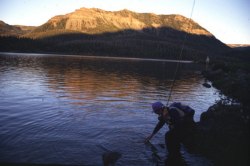
Midges appear near the west shoreline as evening shadows creep across the lake. Ron Belak nets a cutt that took his tiny midge imitation. Photo by Al Marlowe
Midges comprise the bread and butter of the cutthroats' food supply at Trappers Lake. Because midges hatch whenever there is open water, they are particularly important during early spring and late fall when the water is too cold for mayflies and caddis to emerge. Midges hatch at Trappers primarily during early morning and late evening. Their hatch is signaled by telltale dimple rise forms, made when trout gently suck pupae suspended just below the water's surface. Trout gorge themselves so selectively on the tiny pupae that their rise forms often resemble rain. Yet it may be maddeningly difficult to entice a strike because of the midge's small size, relative stillness, and overwhelming abundance. They also tend to hatch in deeper water beyond the casting range of the shore fly fisher.
Midges at Trappers are predominantly black, bottle green, cream, and light tan. These various colors can be fished successfully to differing degrees. For instance, the black midge, which first hatches early after ice-out, is perhaps the easiest of the midges to fish because of its large size. Its pupae are successfully imitated with No. 20 Black Midge Pupa or Grey RS2s. Use floating line with 6X tippet, and retrieve slowly. Adult imitations, such as No. 18 Black Gnats or No. 22 Black Parachutes, also take trout consistently during the hatch. Similarly, the green midge is imitated with olive midge pupae or No. 22 Blue Winged Olive Parachutes. I have little luck with cream and tan midges because of their incredibly small size.
However, one can also ignore the midge matching routine during the evenings and simply fish with a No. 12 Bead Head Orange Asher as a point fly affixed with a trailing No. 20 Andy’s Flash Pupa. This latter fly has a head consisting of peacock herl and a twist of brown soft hackle, a body of Krystal flash ribbed with fine gold wire, and a long tail of Krystal flash. About 15 inches of 5X tippet should separate the two flies. Boarding one’s float tube and stripping this duo in the film produces violent strikes and converts what can be a frustrating experience into a highly productive adventure.
Also, when trout are surface feeding in the shallows, but you cannot see what they are taking, they are probably sipping adult midges. I am extremely successful hooking these cutts on No. 22 Black Parachutes, but you can also stalk these trout successfully with No. 16 Orange Ashers.
If you observe mayflies, it’s probably the genus Callibaetis. Trappers is famous for this hatch. The large, chocolate duns and spinners have speckled wings and light gray underbellies. They first appear at the end of June or beginning of July and hatch into September. However, an algal bloom in early August converts Trappers Lake into a green soupy mix, making this hatch all but impossible to fish for the remainder of the year. The Callibaetis nymphs reside in weed patches just beyond the shelf break, and it is here that the duns emerge, most enthusiastically during the evening. Strong winds, however, preclude their emergence. If you see tails or dorsal fins of trout breaking the surface, they are probably treating themselves to Callibaetis nymphs. These nymphs are effectively imitated with the Gold Ribbed Hares Ear or No. 16 Pheasant Tails. Vigorously strip these flies on a floating line. Fish can periodically be taken throughout the hatch on dun imitations -- No. 14 or 16 Adams, Mosquitoes, Blue Duns, or Light Cahills.
During the late morning and early afternoon, you may observe clouds of Callibaetis spinners completing their mating ritual. Clouds form closer to shore and are therefore more accessible to wading. A gentle breeze commonly blows individuals onto the water, females touch down to deposit eggs, or spent individuals may simply fall. You can fish the same dun imitations without worrying about spent wings. At times, cutts feed so enthusiastically on Callibaetis spinners that almost any No. 12 to 16 dry fly is effective. The best patterns, however, include the Mosquito, Adams, Quill Gordon, Blue Dun, and White Quill.
Caddis are also important at Trappers Lake, and they first appear in spring at the same time as Callibaetis. Caddis seldom form extensive hatches except under overhanging willows right up against shore; so trout seldom feed selectively upon them. The cutts, however, will take adult caddis whenever available, and caddis become more important when the Callibaetisare not hatching. Adult caddis are best imitated with No. 16 or 18 Elk Hair Caddis. They often rise to this fly on the choppiest of surfaces, and sometimes a sunk fly entices more strikes.
During late July and August, you may encounter cutts vigorously feeding on flying ants. The heavy-bodied inexperienced aviators frequently find themselves blown onto the water's surface where they are quickly devoured. These trout treats are easily imitated with No. 16 Renegades or No. 14 Flying Ants, fashioned from dark chocolate dubbing and mallard quill.
The most overlooked food source at Trappers is the crustacean Gammarus, commonly known as the scud. The Division of Wildlife found scuds in 37 percent of stomach samples examined. Scuds at Trappers are greenish gray and most abundant in sizes No. 18 and 20. Scuds should be retrieved erratically on a sinking line along the margins of weed beds or dangled in front of trout cruising the shallows. The take is often subtle, and you will need to set the hook.
Cruising trout that refuse dries can be tempted with various nymphs. By walking the banks, even during midday, you can often observe trout cruising in as little as one foot of water. I catch many of these fish by dangling a No. 12 Bead Head Caddis tied with light tan dubbing. The light color is easy to see even through a rippled surface, and the bead gets the fly down without the use of split shot. The trout do not strike hard, but avoid using indicators as they spook many fish. Other flies effective on cruisers include Hares Ears, Pheasant Tails, Scuds, and San Juan Worms.
Undoubtedly, the more you fish Trappers Lake, the more you will learn of its secrets. Perhaps you will discover a hatch of mayflies blown off an inlet stream, experience a profusion of beetles struggling helplessly on the water, or encounter a number of leeches squirming along the substrate. The more you learn, the more you will enjoy this Flat Tops treat.
Access and Accommodations:
To reach Trappers Lake, drive Routt County 17--the scenic byway over Dunkley and Ripple Creek Passes--from Yampa 41 miles west to Trappers Lake Road. Proceed south for 8 miles to the trailhead parking lot. From Meeker, take Rio Blanco County 8 41 miles east to Trappers Lake Road. There are over 100 maintained Forest Service campsites available on a first come basis within two miles of the lake. Cabins, meals, and boats are available at Trappers Lake Lodge.Resources:
Read another story about fishing Trapper's Lake and the Flat Tops The Flat Tops and Trappers Lake - a photo essay
 Al
has written a book, "Fly Fishing the Flat Tops". You can order a paperback copy through
Barnes and Noble, or
Amazon. This book
gives descriptions and locations of almost every fishing opportunity in the Flat Tops.
Al
has written a book, "Fly Fishing the Flat Tops". You can order a paperback copy through
Barnes and Noble, or
Amazon. This book
gives descriptions and locations of almost every fishing opportunity in the Flat Tops.
 Al
has another book, "The Hiking and Camping Guide to Colorado's Flat Tops Wilderness" . You can order a paperback or ebook copy through
Barnes and Noble, or
Amazon. This book
describes trails and includes maps to make your Flat Tops
trip more easy to plan and enjoy.
Al
has another book, "The Hiking and Camping Guide to Colorado's Flat Tops Wilderness" . You can order a paperback or ebook copy through
Barnes and Noble, or
Amazon. This book
describes trails and includes maps to make your Flat Tops
trip more easy to plan and enjoy.
This article first appeared in the 1995 annual fishing guide issue of Colorado Outdoors magazine. The article is copyrighted by the author, so unauthorized reproduction of this article is not allowed. All photos are copyrighted by Al Marlowe. No reproduction, linking, or copying without permission.

